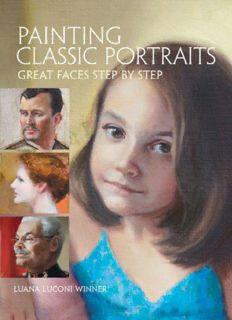
Painting classic portraits : great faces step by step PDF
Preview Painting classic portraits : great faces step by step
Robert Case in Maggie Valley Pastel on Ampersand Pastelbord 20” × 16” (51cm × 41cm) Painting Classic Portraits GREAT FACES STEP BY STEP Luana Luconi Winner Cincinnati, Ohio www.artistsnetwork.com Contents Painting Classic Portraits Introduction Materials and Grounds References, Studies & Composition Control the Viewer’s Order of Sight Sketching Techniques and Collecting References Values Control Form Composing the Story Making Tonal Studies Quarter-Size Study: The Color Plan Photography as Note-Taking Digital Techniques in the Art Studio Constructing the Head & Features Think Like a Sculptor The Eyes Constructing the Eye, Front View The Eye in Profile Construct the Nose The Nose in Profile The Mouth The Mouth Ears Four Ways to Proportion the Head Sculpt With Paint Understand What’s Underneath Train Yourself With Sketching Hair Facial Hair Eyebrows Hands: An Extension of Expression Female Hands at Different Ages Men’s Hands The Colors of People: Skin & Hair Color Considerations How to Use the Color Charts Brunette Blue Blood/Porcelain Blonde Hispanic/Latino Black, Warm Tones Black, Cool Tones East Asian Native American Indian (Continental) Design Decisions Building the Portrait Within the Subject’s World The Artist as Storyteller Lighting the Subject Clothing Sets Formal or Informal Tone Accessories: Jewelry and Eyeglasses Backgrounds and Props Color: Subtle vs. Saturated Edges: Spontaneous Sketch or Careful Rendering? Demonstrations Classical Singer in Oils Gentleman Outdoors in Oils Sisters in Pastel Color Reference Chart for Pastel GABBY Oil 24” × 20” (61cm × 51cm) ELIZABETH Pastel on Ampersand Pastelbord—sand tone 20 × 16 (51cm × 41cm) Silver medal, International Association of Pastel Societies Introduction Art should make us sense something, whether it’s sympathy, anger, satisfaction or love. It should make us question or evoke a memory. Paintings and sculpture should encourage us to react to more than the mere material from which they are created. The portrait must depict a singular, particular life, one with heart and soul and memories and feelings of its own. Can we paint that into a portrait? Painting great faces never loses its intrigue or challenge because even with a set, repetitive, mathematical pattern—two eyes, one nose, one mouth, two ears— the slightest change of a line or movement in the shadow will create an entirely different face. Think of it: There are seven billion people on the planet and no two people look precisely alike. We have our work cut out for us. While an artist finds an effective way to collect pertinent data required to tell the sitter’s story, the preparatory sketches become key to linking the subject, her history and the accoutrements of their life into one beautiful composition. The portrait tells a story. Don’t ignore or rush this vital element when you have the opportunity to get to know your subject. Remember that during the initial sketch sitting, the subject is often fighting nerves worrying about how to remain still, how he really looks to others and how to remain comfortable and self-confident as this stranger stares and studies him in detail. The artist, in turn, is concerned about making the subject comfortable and less self-conscious while collecting pertinent information. To paint the person, get inside his persona to tell the truest story. Do this in the time allotted and with the highest level of skill. Do not cut corners. Do the work. Artists should always be reaching further, delving deeper, stretching wider as they attempt to attain a new level of truth and wisdom. Here are some thoughts before we proceed: Decisions at the start affect the finish. At the beginning, the artist should have a clear plan. There will be minor changes of the movement of a skirt, the tilt of the flower in the vase or a touch of sunlight that has moved slightly. This does mean that if the painting is planned as a seated person with one hand on a dog, we do not, in the middle of production, take out the dog, put in a desk, and move the hands and arms. We begin a new canvas for the new image and design. It needs to always stay fresh and feel spontaneous, not overworked. There are no disclaimers displayed on paintings. No opportunity to explain what it should have been, what it could have been. If you are the type of person who should not be rushed, don’t set a deadline. A painting that is rushed, or repeatedly changed or repaired, reveals all of that. The viewer will see the struggle. Step away and make a plan. Do a drawing again and again until you can really see the finished painting in your head —then just lay it on the canvas. You have looked at faces since the moment you were born. Now it is time to look into faces and souls. Do not distract the viewer with unskilled anatomy. We will simplify things into straightforward, uncomplicated, geometric shapes. Nothing will be too intimidating to tackle. We live in a world of amazing color, but people’s skin needs to be painted true to their ethnicity or blend of ethnicities. The color charts will give you the confidence to dive right into the painting, but remember, no one chart is going to be perfect for anyone. Take the theory, the color family and the process, and adapt it to suit your particular model’s needs. We will learn together how to tell stories in our images. How can you succinctly tell the viewer two hundred years from now who this person was and what he felt? You are recording his history. Make it count. Does the final painting match your perception of perfect? No? Move on! There is always more blank canvas out there just waiting for you. You will hear repeatedly, “You will only be as good as the miles of canvas you have covered.” So let’s get started!
Description: